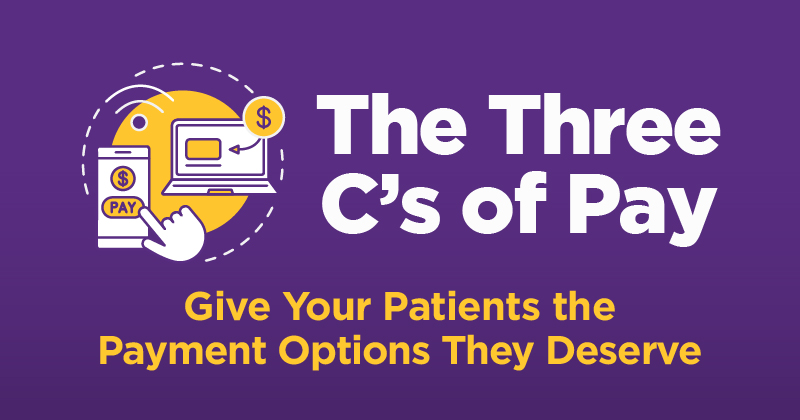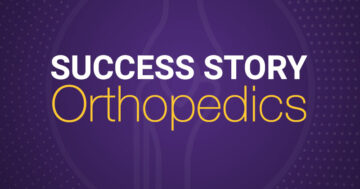The Three C’s of Pay: Give Your Patients the Payment Options They Deserve

Remember the days of holding up the supermarket checkout line while you hand-wrote a check to pay for your groceries? Then you had to manually record the check number, payee and amount in your check register? And who could forget the dreaded evenings spent sifting through receipts and records, balancing your checkbook every month?
Fortunately, the days when patients were limited to writing and mailing checks to pay for a trip to the doctor are long gone.
These days, most people probably don’t even own a checkbook, and those who do most likely have it stashed away somewhere, collecting dust. The world of making payments, and the number of payment options available, have drastically changed.
What does that mean for patients making healthcare payments?
We wanted to better understand what patients are looking for when it comes to their healthcare experience. So we surveyed 2,000 patients, seeking answers about what patients expect from their doctor’s office and the overall experience – both in-office and online.
Among others, one goal of our ModMedⓇ 2022 Patient Experience Report: “What Patients Really Think”* was to find out how payment processing may affect a patient’s experience — from how quickly a patient will pay their bill to a patient’s likelihood to return to see the same doctor.
Given the plethora of payment options available today, how can healthcare practices adapt and offer patients the options they’re looking for?
Provide a payment experience that centers around the three C’s of customer delight: Comfort, Convenience and Control.
1. COMFORT: Give patients the option to make healthcare decisions surrounded by all their creature comforts
We’ve witnessed firsthand how our day-to-day lives can be affected by a global pandemic. When restaurants, stores, pharmacies and clinics were forced to close their doors to the public, it altered “normal” life in ways we couldn’t have predicted. With in-person interactions limited, virtual connectivity became a staple in every home, and with it came a higher expectation for technology to meet our needs while allowing us to remain safely inside our homes.
Our study revealed that more than 1 in 3 patients (35%) admitted they might avoid going to a specialist appointment simply because it’s not conveniently located or is too far away.11 Offering virtual Telehealth visits and giving patients the option to pay their balance online in the Patient Portal could not only help keep patients safe and comfortable at home, but it may even help your practice broaden its patient base beyond just the local area.
2. CONVENIENCE: Simplify and streamline the payment experience
We make decisions every day based on convenience. Groceries delivered with a tap. School supplies dropped off at your door. Convenience can also play a major role in the way patients choose their doctors, and could, therefore, even affect the success of your practice.
Creating easier ways for patients to make payments could lead to more on-time payments.
Consider that more than half of patients in our survey (53%) are more likely to pay a bill from their doctor’s office faster if they receive a text message reminder38*, and 59% are likely to pay faster if given an online option.37*
Convenient payment options could play a role in helping your practice retain patients as well. When deciding whether to return to see the same doctor, 61% of respondents placed importance on being able to make payments easily.4*
Additionally, 40% said they prefer making payments online, via text, autopay or payment apps after an in-person doctor visit.14
This insight helps reveal the importance that many patients place on convenience when it comes to their healthcare payment experience. Giving patients streamlined and modern payment options is a great way to cater to patients’ expectation of convenience, so your patients keep coming back.
“Since bringing in payment software, almost immediately patients started making payments virtually. They like the convenience of getting a text link to make payments on their account, for example. We’ve experienced a solid two-week decrease in payment time after we send out billing.”
Dawn Ricker, Practice Administrator
Dermatologic Surgery Center of Northeast Ohio
Looking for more ways to offer convenience? Consider an all-in-one EHR, incorporated with Patient Portal – where they can access their account, schedule appointments and more – and when integrated with ModMed Pay, allows patients to view and pay their balance too – all in one place they can access from virtually anywhere.
3. CONTROL: Empower your patients to participate in their own healthcare experience
Giving your patients a choice in payment options is another way of putting them in the driver’s seat. We learned from our survey that when given the chance, 48% of patients are likely to store credit card information on file to make payments automatically39*.
Offering services like autopay, allowing patients to save a card on file for future payments, can be an effective way to put the power in your patients’ hands and may even help your practice receive more on-time payments.
ModMed Pay: Payment Processing. Simplified.
If your practice is struggling to meet the growing demand for mobile payment options, it might be time to consider switching to a platform that can not only offer multiple payment solutions – both online and in-person – to fit your patients’ needs, but can also help improve office efficiency and reduce some of the tedium of chasing down payments.
This blog is intended for informational purposes only and does not constitute legal or medical advice. Please consult with your legal counsel and other qualified advisors to ensure compliance with applicable laws, regulations, and standards.
11, 38, 37, 4, 14, 39 See survey questions, 11, 38, 37, 4, 14, and 39 in the Appendix of the 2022 ModMed Patient Experience Report: “What Patients Really Think”.
*Data reflected is a combined stat of ‘very important’ and ‘somewhat important’, ‘very likely’ and ‘somewhat likely’, or ‘strongly agree’ and ‘somewhat agree’ as applicable.
**These two random double-opt-in surveys, both of which used a panel of 1,500 insured and 500 uninsured Americans, were commissioned by ModMed between Feb. 2 and Feb. 4, 2022. They were conducted by market research company OnePoll, whose team members are members of the Market Research Society and have corporate membership to the American Association for Public Opinion Research (AAPOR) and the European Society for Opinion and Marketing Research (ESOMAR).







